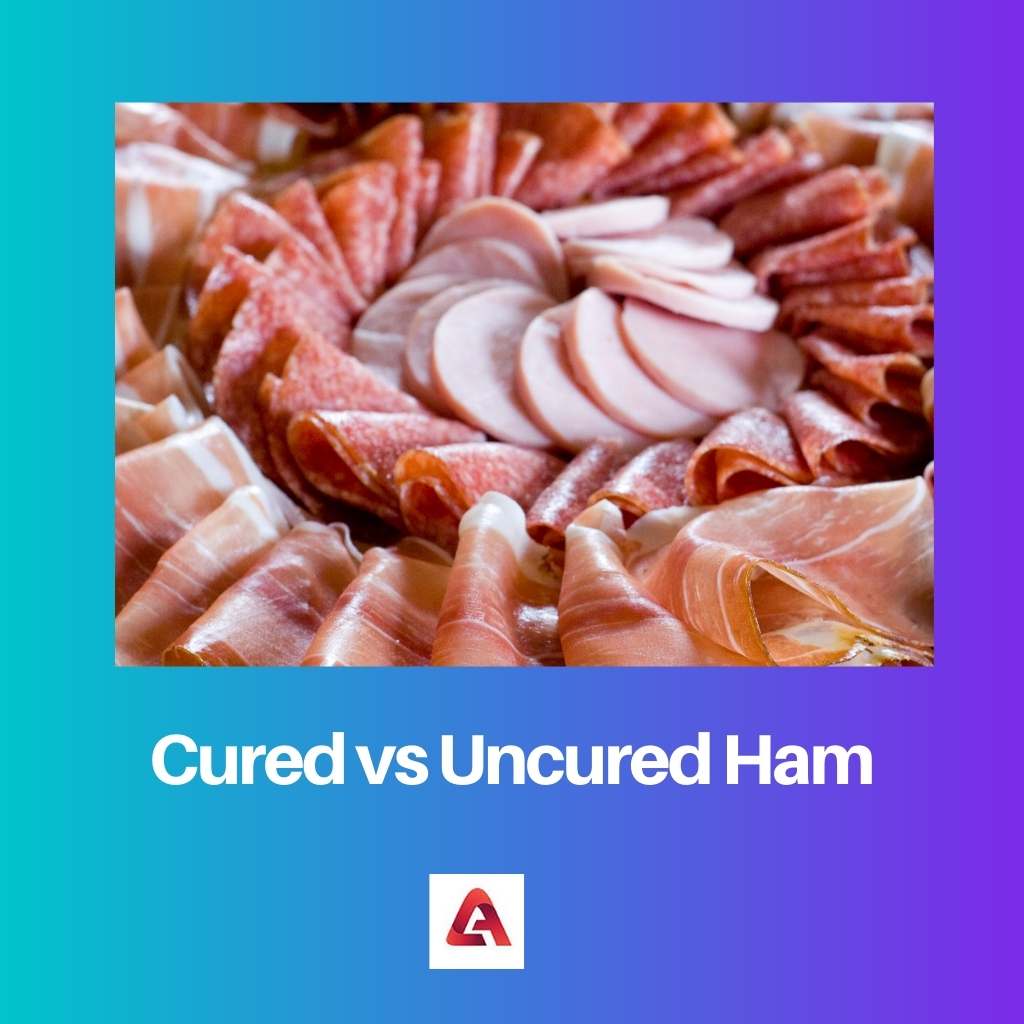A ham is a piece of meat that we get from the pork leg’s part. Ham is produced in many countries in different ways. Every country has different ways of preparing ham.
They are used in sandwiches, burgers, and pizzas. They are very good for storing purposes.
General Zong Ze is the person who introduced ham. Today, Spain is the largest producer of Ham.
Key Takeaways
- Cured ham has been treated with a curing agent, such as salt, whereas Uncured ham hasn’t been treated with any curing agent.
- Cured ham has a longer shelf life than Uncured ham, whereas Uncured ham is healthier as it contains no nitrates or nitrites.
- Cured ham has a distinct salty flavor, whereas Uncured ham has a milder flavor.
Cured vs Uncured Ham
Cured ham is made by adding salt and various other curing agents to the raw meats. Uncured ham is not treated with curing agents, instead, preserved using natural methods such as salting, smoking, or air-drying, it has a different flavor and texture than cured hams and is more expensive.

The cured ham is the ham from which excess water content is removed; therefore, the shelf period of the meat is increased. Thus, these water differences also introduce two types of ham: dry and wet ham.
But, less water content destroys the flavors of the meat and also changes the taste of the meat. The nitrates contents also increase in the ham because of the preservative that is being used.
The uncured ham is the ham that is preserved using celery powder and sea salt. This preserves the meat’s natural flavor and gives it the perfect texture.
The uncured ham is free from nitrates because of the natural method of preserving ham.
Comparison Table
| Parameters of Comparison | Cured Ham | Uncured Ham |
|---|---|---|
| Definition | The ham that is being preserved using the brine method and other man-made preservatives is called cured ham. | The uncured ham is preserved from sea salt. |
| Water Content | The water content is found around 35% to 45% in the ham. | The uncured meat contains 70% to 80% of water content. |
| Fat Percentage | The fat is found in around 4% of the 57gm of ham. | The fat is around 3% in the uncured ham. |
| Protein | The cured ham consists of 25.48g protein in 57gm of ham. | The protein is around 4gm in 57gm of ham. |
| Health Effects | It has been seen that cured ham has caused many health issues due to excessive sodium nitrate concentration in the ham. | The uncured ham is more healthy as compared to the cured ham. |
| Calories | The cured ham provides around 69 calories in 57gms of ham means in three slices. | The uncured ham has 70calories in 57gm. |
| Flavors | The cured ham is found to lose the flavors due to loss of water content. | They have a better and fine taste as compared to the cured ham. |
| Expiry | The cured ham is expired within six months. | The uncured ham expires in four months in the frozen state. |
| Process of making | The cured ham requires the whole cooking recipe before it is served. | The uncured ham is just heated before serving. |
What is Cured Ham?
The cured ham is the flesh that is preserved using man-made or, we can also say, artificial preservatives. They are good for transportation purposes.
The cured ham has less water content, increasing the flesh’s lifetime. These ham also have sodium and nitrate content a bit high because of the presence of preservatives.
These cured ham lose their natural flavors as the water content decrease and also changes their textures. Cured ham comes in two types:- wet and dry ham.
These hams are then used differently. Wet ham is used as bacon, and dry ham is used as slicing in sandwiches.

What is Uncured Ham?
The uncured ham is a piece of meat that is preserved using traditional methods like sea salt. The ham has 70-80% of water in it, which makes it better in taste and flavor.
The uncured ham is ready-to-make meat that is just heated in the oven, and the meat is ready to serve. These days people are busy and prefer food items that are healthy, tasty, and easy to make.
Therefore, uncured ham is the best option available for this purpose. The uncured ham went through many controversies when it first came into the market.
The people questioned, “Are they safe or not?”. Later the experts answered the questions along with the proof that they were safe.
The reason that maximally commercialized was the natural method that made it a trusting method. The experts gave the reasoning by showing an experiment that showed that the uncured ham doesn’t produce any cancerogenic substrates in the body.

Main Differences Between Cured and Uncured Ham
- The cured ham is preserved using the brine method, and the uncured ham is preserved using natural methods.
- The uncured ham has 80% of water content, about twice the amount of water content present in cured ham.
- Cured ham is meat with more traces of nitrates than cured ham.
- Uncured ham is found to be healthier as compared to cured meats because of the difference in the preservations method.
- The cured ham(25.49gm) has more protein than the uncured ham(4gm).
- The uncured ham is easy to make as compared to the cured ham.




